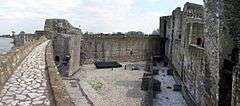Please tell us which country and city you'd like to see the weather in.

Smederevo
Smederevo (Serbian Cyrillic: Смедерево, pronounced [smêderevo]) is a city in Serbia, on the right bank of the Danube, about 45 kilometres (28 miles) downstream of the capital Belgrade. According to official results of the 2011 census, the city has a population of 64,105, and 108,209 people live in its administrative area. Smederevo is the seat of the Podunavlje District.
Its history starts in the 1st century BC, with the conquerings of the Roman Empire, when there existed a town called Vinceia. The modern city traces its roots back to the late Middle Ages when it was the capital (1430–1439 and 1444–1459) of the last independent Serbian state before the Ottoman conquest.
Name
In Serbian, the city is known as Smederevo (Смедерево), in Latin, Romanian and Greek as Semendria, in Hungarian as Szendrő or Vég-Szendrő, in Turkish as Semendire. The name of Smederevo was first recorded in the Charter of the Byzantine Emperor Basil II from 1019, in the part related to the Eparchy of Braničevo in Ohrid Bishopry. Another written record is found in the Charter of the Duke Lazar from 1381 by which he bestowed the Monastery of Ravanica and villages and properties ’to the Great Bogosav with the commune and heritage’’.

Smederevo Airport
Smederevo Airport (Serbian: Аеродром Смедерево / Aerodrom Smederevo) (ICAO: LYSD) is a airport in Serbia located in the vicinity of the city of Smederevo (4 km southeast of the centre, near the road 14 that connects Smederevo–Kovin). Activities include sport and training flights of aircraft and gliders, agricultural airplanes, helicopters, and parachuting.
There is a concrete apron of 20x40 m.
See also

Smederevo Fortress
The Smederevo Fortress (Serbian: Cмeдepeвcκa твpђaвa, Smederevska tvrđava) is a medieval fortified city in Smederevo, Serbia, which was temporary capital of Serbia in the Middle Ages. It was built between 1427 and 1430 on the order of Despot Đurađ Branković, the ruler of the Serbian Despotate. It was further fortified by the Ottoman Empire, that had taken the city, in the end of the century.
The fortress withstood several sieges by Ottomans and Serbs, which it survived relatively unscathed. It was not until World War II that it was heavily damaged, by explosions and bombing. As of 2009 it is in the midst of extensive restoration and conservation work, despite which the fortress remains "one of the rare preserved courts of medieval Serbian rulers."
Smederevo Fortress was declared a national Monument of Culture of Exceptional Importance in 1979. In 2010, the fortress was placed on the tentative list for possible nomination as a World Heritage Site (UNESCO).
Location
Smederevo Fortress, 45 kilometers southeast of Belgrade, covers 11.3 hectares in the center of the modern-day city of Smederevo. It is strategically located on the right bank of the Danube river on the triangular plain formed by the confluence of the Danube and Jezava rivers, only 72 meters above sea level. This location allowed the Serbian capital to remain near the Christian Kingdom of Hungary, while also satisfying Sultan Murad II of the Ottoman Empire by eliminating the uncontrolled passage of the Hungarians into the Morava valley.
Radio Stations - Smederevo
SEARCH FOR RADIOS
Podcasts:

